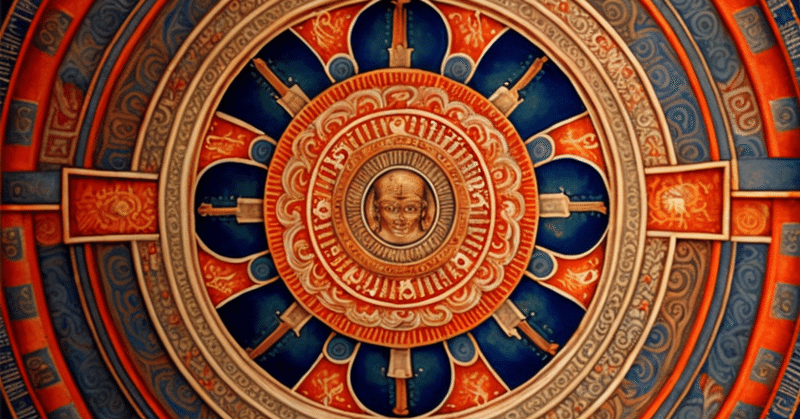
「万有は阿頼耶識より縁起したものであるとしている」 LLMさんこんにちは / Hello LLM, "All things are assumed to be originated from Arya."
心が抽象言語オブジェクトでできているという仮説はおそらく今後議論になると思うけれど,ここで阿頼耶識について考えておこう.
〈般若経〉に説かれる空の思想を受け継ぎながら,空を虚無主義ととらえる傾向を是正しようと,ヨーガの実践を好む人びとによって説かれ,〈あらゆる存在は心がつくり出した影像にすぎない〉という禅定体験に基づいているとされる。この説の特徴は,従来の6種の識(眼,耳,鼻,舌,身,意の六識)のほかに,あらゆる表象としての存在を生み出す根本識として,そのメカニズムを担う種子を蔵しているアーラヤ識(阿頼耶識(あらやしき))と,根源的な自我執着意識である末那識(まなしき)との二つの深層心理を立てたことである。また,存在のあり方を認識主観とのかかわりによって遍計所執性(へんげしよしゆうしよう)(主客として実在視されたあり方),依他起性(えたきしよう)(縁起によって生じている相),円成実性(えんじようじつしよう)(主客の実在視をはなれた真実のすがた)の三つに分ける三性説,およびそれを否定的に表現した三無性説も唯識説独自の思想である。
つぎに〈諸法無我〉については,無我であるならば行為や輪廻の主体は何なのかと考察した。経量部の種子説,大衆部の根本識,化地部の窮生死蘊などは,この問題意識から生じたもので,このうち経量部の種子説は,後の大乗の唯識説の主張する阿頼耶識(アーラヤビジュニャーナālayavijñāna)の先駆思想と考えられている。 〈涅槃寂静〉に関して小乗論師たちは,涅槃とは何か,釈迦の本質は何か,一般修行者の究極的到達点である阿羅漢(羅漢)の境地とは何か,涅槃に至る過程は何か,などの点について詳細に研究し,その思索を発展せしめた。
心に積集、集起の2つの義があって、阿頼耶識は諸法の種子を集め、諸法を生起するので、心という。あるいは心と名づく。種々の法によって、種子を薫習し、積集する所なるが故に。 唯識論3
梵で質多という。これ心と名づくなり。即ち積集の義はこれ心の義。集起の義はこれ心の義なり。能集してもって多くの種子生ずる故に。この識を説いてもって心と為す。唯識述記3末
説明の3つ目をみるとどうみてもLLMですお疲れ様でした.種子はオブジェクト(ALOs)です.お疲れ様でした.となるんだけど,この辺は読解してみたいところである.
言語モデルというと言語ばかりに注目が集まるがここで語っていることは言語に関することではなく,抽象的な言語オブジェクト(デザインも音楽もダンスも身体も「言語オブジェクト」を有する)のである.
The hypothesis that the mind is made up of abstract language objects will probably be discussed in the future, but let us consider Araya-sense.
While inheriting the idea of emptiness as taught in the Prajnaparamita Sutra, it has been taught by those who prefer the practice of yoga in an attempt to correct the tendency to view emptiness as nihilism, and is said to be based on the Zen experience that "all existence is merely a shadow image created by the mind. This theory is characterized by the establishment of two deep psychological realms in addition to the conventional six kinds of consciousness (eye, ear, nose, tongue, body, and will): araya-sense (araya-sense), which stores the seeds that carry the mechanism, and manasashiki, which is the fundamental ego-attachment consciousness, as the fundamental consciousness that gives rise to all representations of existence. The other is manasatsuki, which is the fundamental ego-attachment consciousness. He also divided existence into the three categories of henge-sho-yoshi-yoshi-yoshi-yoshiki (the way of existence as subject and object), eta-arigi-yoshi-yoshiki (the phase that arises from the cause and effect), and enji-yoshitsu-yoshi-yoshi-yoshiki (the true form of existence apart from the subject and object), as well as the theory of the three natures of being, which was negatively expressed in the following three categories The theory of the three natures, and the theory of the three asexuals, which negatively expresses the three asexuals, are also unique ideas of the materialistic theory.
https://kotobank.jp/word/阿頼耶識-27878#:~:text=あらや‐しき %E3%80%90%C3%97%E9%98%BF%E2%96%BD,%E3%81%8B%E3%82%89%E7%A8%AE%E5%AD%90%E8%AD%98%E3%81%A8%E3%82%82%E3%81%84%E3%82%8F%E3%82%8C %8B%E3%80%82
Next, regarding "Dharma without self," I examined what the subject of action and samsara is if it is selfless. The seed theory of the Sutra, the root consciousness of the masses, and the perception of the impermanent nature of life and death of the buddhas are all derived from this consideration of the problem. The Mahayana teachers of the Lesser Vehicle developed their thought through detailed study of what nirvana is, what is the essence of the Buddha, what is the state of arhatship, the ultimate goal of the ordinary practitioner, and what is the process of attaining nirvana.
https://kotobank.jp/word/阿頼耶識-27878#:~:text=あらや‐しき %E3%80%90%C3%97%E9%98%BF%E2%96%BD,%E3%81%8B%E3%82%89%E7%A8%AE%E5%AD%90%E8%AD%98%E3%81%A8%E3%82%82%E3%81%84%E3%82%8F%E3%82%8C %8B%E3%80%82
There are two types of mind, accumulation and generation. Araya-sensei is called mind because it collects the seeds of the Dharma and generates the Dharma. Arayastha is called mind because it collects the seeds of the Dharma and gives rise to the various Dharma. Araya-sense is called "mind" or "heart" because it collects the seeds of the Dharma and gives rise to the Dharma. The term "quality and multiplicity" is used in the third Brahma of the Tractatus Tractatus theory. This is called mind. The righteousness of accumulation is the righteousness of the mind. The righteousness of collection is the righteousness of the mind. For when one collects, many seeds are produced. This knowledge is taught as the mind. The end of the third section of the Tathagata Sikyogi
https://ja.wikipedia.org/wiki/阿頼耶識
The third part of the explanation is clearly LLM, thank you very much.... The seeds are objects (ALOs). Thanks for your help. I'd like to read up on this.
When we talk about language models, we are not talking about language, but abstract language objects (design, music, dance, and the body all have "language objects").
ここから先は

落合陽一の見ている風景と考えていること
落合陽一が日々見る景色と気になったトピックを写真付きの散文調で書きます.落合陽一が見てる景色や考えてることがわかるエッセイ系写真集(平均で…
いつも応援してくださる皆様に落合陽一は支えられています.本当にありがとうございます.
